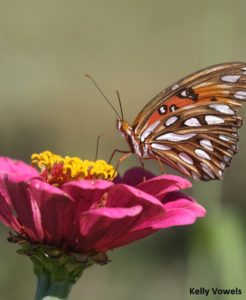By Bernheim
 Did you know that butterflies taste with their feet? When a butterfly lands on a flower, it will tap the flower and leaves of the plant to make sure it is either a nectar or host plant. This will cause the tongue, or proboscis, to uncoil and extend into the flower. Tapping the host plant ensures it is the proper flower for the butterfly to deposit its egg. During this process, pollen gathers on their feet, legs, body, and tongue ready to be transported to the next flower. Because of the butterfly’s longer legs and body shape, it cannot collect as much pollen as a bee can, but they are better at maneuvering into long tubular flowers because of their proboscis.
Did you know that butterflies taste with their feet? When a butterfly lands on a flower, it will tap the flower and leaves of the plant to make sure it is either a nectar or host plant. This will cause the tongue, or proboscis, to uncoil and extend into the flower. Tapping the host plant ensures it is the proper flower for the butterfly to deposit its egg. During this process, pollen gathers on their feet, legs, body, and tongue ready to be transported to the next flower. Because of the butterfly’s longer legs and body shape, it cannot collect as much pollen as a bee can, but they are better at maneuvering into long tubular flowers because of their proboscis.
Second only to bees as a pollinator, butterflies have color preferences as well. Purple, yellow, white and orange plants are top choices. Therefore, the more variety of flowers in your garden, the better for butterfly attraction. One of the most important additions to your garden is milkweed (asclepias), especially for monarch butterflies. This flower is a host for the caterpillar and provides nectar for the butterfly. A little research on flowers that attract butterflies of many species will ensure that these little beauties will stop by for a sip.
Happy butterflying!
-Corinne Mastey, Bernheim Volunteer Naturalist

